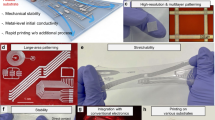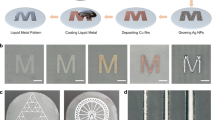Abstract
Conductive and stretchable electrodes that can be printed directly on a stretchable substrate have drawn extensive attention for wearable electronics and electronic skins. Printable inks that contain liquid metal are strong candidates for these applications, but the insulating oxide skin that forms around the liquid metal particles limits their conductivity. This study reveals that hydrogen doping introduced by ultrasonication in the presence of aliphatic polymers makes the oxide skin highly conductive and deformable. X-ray photoelectron spectroscopy and atom probe tomography confirmed the hydrogen doping, and first-principles calculations were used to rationalize the obtained conductivity. The printed circuit lines show a metallic conductivity (25,000 S cm–1), excellent electromechanical decoupling at a 500% uniaxial stretching, mechanical resistance to scratches and long-term stability in wide ranges of temperature and humidity. The self-passivation of the printed lines allows the direct printing of three-dimensional circuit lines and double-layer planar coils that are used as stretchable inductive strain sensors.
This is a preview of subscription content, access via your institution
Access options
Access Nature and 54 other Nature Portfolio journals
Get Nature+, our best-value online-access subscription
$29.99 / 30 days
cancel any time
Subscribe to this journal
Receive 12 print issues and online access
$259.00 per year
only $21.58 per issue
Buy this article
- Purchase on Springer Link
- Instant access to full article PDF
Prices may be subject to local taxes which are calculated during checkout





Similar content being viewed by others
Data availability
All the data that support this study are included in this article and its supplementary information files. Source data are provided with this paper.
References
Gao, W. et al. Fully integrated wearable sensor arrays for multiplexed in situ perspiration analysis. Nature 529, 509–514 (2016).
You, I. et al. Stretchable E-skin apexcardiogram sensor. Adv. Mater. 28, 6359–6364 (2016).
Xu, S., Jayaraman, A. & Rogers, J. A. Skin sensors are the future of health care. Nature 571, 319–321 (2019).
Wang, S., Oh, J. Y., Xu, J., Tran, H. & Bao, Z. Skin-inspired electronics: an emerging paradigm. Acc. Chem. Res. 51, 1033–1045 (2018).
Chortos, A., Liu, J. & Bao, Z. Pursuing prosthetic electronic skin. Nat. Mater. 15, 937–950 (2016).
Yu, X. et al. Skin-integrated wireless haptic interfaces for virtual and augmented reality. Nature 575, 473–479 (2019).
Dickey, M. D. Stretchable and soft electronics using liquid metals. Adv. Mater. 29, 1606425 (2017).
Chu, K. et al. Smart passivation materials with a liquid metal microcapsule as self-healing conductors for sustainable and flexible perovskite solar cells. Adv. Funct. Mater. 28, 1800110 (2018).
Roh, H. et al. Liquid metal covered with thermoplastic conductive composites for high electrical stability and negligible electromechanical coupling at large strains. ACS Appl. Mater. Interfaces 11, 26204–26212 (2019).
Kim, H. W. et al. Hygroscopic auxetic on-skin sensors for easy-to-handle repeated daily use. ACS Appl. Mater. Interfaces 10, 40141–40148 (2018).
Song, J. H. et al. Surface-embedded stretchable electrodes by direct printing and their uses to fabricate ultrathin vibration sensors and circuits for 3D structures. Adv. Mater. 29, 1702625 (2017).
Choi, S., Han, S. I., Kim, D., Hyeon, T. & Kim, D. H. High-performance stretchable conductive nanocomposites: materials, processes, and device applications. Chem. Soc. Rev. 48, 1566–1595 (2019).
Hirsch, A., Dejace, L., Michaud, H. O. & Lacour, S. P. Harnessing the rheological properties of liquid metals to shape soft electronic conductors for wearable applications. Acc. Chem. Res. 52, 534–544 (2019).
Daeneke, T. et al. Liquid metals: fundamentals and applications in chemistry. Chem. Soc. Rev. 47, 4073–4111 (2018).
Boley, J. W., White, E. L. & Kramer, R. K. Mechanically sintered gallium–indium nanoparticles. Adv. Mater. 27, 2355–2360 (2015).
Wang, J. X. et al. Printable superelastic conductors with extreme stretchability and robust cycling endurance enabled by liquid–metal particles. Adv. Mater. 30, 1706157 (2018).
Xin, Y. M., Peng, H., Xu, J. & Zhang, J. Y. Ultrauniform embedded liquid metal in sulfur polymers for recyclable, conductive, and self-healable materials. Adv. Funct. Mater. 29, 1808989 (2019).
Markvicka, E. J., Bartlett, M. D., Huang, X. N. & Majidi, C. An autonomously electrically self-healing liquid metal–elastomer composite for robust soft-matter robotics and electronics. Nat. Mater. 17, 618–624 (2018).
Zhu, S. et al. Ultrastretchable fibers with metallic conductivity using a liquid metal alloy core. Adv. Funct. Mater. 23, 2308–2314 (2013).
Guo, R., Sun, X. Y., Yuan, B., Wang, H. Z. & Liu, J. Magnetic liquid metal (Fe-EGaIn) based multifunctional electronics for remote self-healing materials, degradable electronics, and thermal transfer printing. Adv. Sci. 6, 1901478 (2019).
Wang, X. L. et al. Soft and moldable Mg-doped liquid metal for conformable skin tumor photothermal therapy. Adv. Healthc. Mater. 7, 1800318 (2018).
Tang, J. B. et al. Gallium-based liquid metal amalgams: transitional-state metallic mixtures (TransM2ixes) with enhanced and tunable electrical, thermal, and mechanical properties. ACS Appl. Mater. Interfaces 9, 35977–35987 (2017).
Zheng, R. M. et al. A novel conductive core–shell particle based on liquid metal for fabricating real-time self-repairing flexible circuits. Adv. Funct. Mater. 30, 1910524 (2020).
Çınar, S., Tevis, I. D., Chen, J. & Thuo, M. Mechanical fracturing of core–shell undercooled metal particles for heat-free soldering. Sci. Rep. 6, 21864 (2016).
Desai, V., Shenoy, M. A. & Gogate, P. R. Ultrasonic degradation of low-density polyethylene. Chem. Eng. Process. 47, 1451–1455 (2008).
Liu, S. Q., Gong, W. G. & Zheng, B. C. The effect of peroxide cross-linking on the properties of low-density polyethylene. J. Macromol. Sci. B 53, 67–77 (2014).
Suslick, K. S., Gawienowski, J. J., Schubert, P. F. & Wang, H. H. Alkane sonochemistry. J. Phys. Chem. 87, 2299–2301 (1983).
Kim, M. H. et al. Photochemical hydrogen doping induced embedded two-dimensional metallic channel formation in InGaZnO at room temperature. Acs Nano 9, 9964–9973 (2015).
Cademartiri, L. et al. Electrical resistance of AgTS–S(CH2)n−1CH3//Ga2O3/EGaIn tunneling junctions. J. Phys. Chem. C 116, 10848–10860 (2012).
Zhang, C. et al. Plasma treatment of ITO cathode to fabricate free electron selective layer in inverted polymer solar cells. J. Mater. Chem. C 2, 8715–8722 (2014).
Huang, C. J. et al. Effect of OH– on chemical mechanical polishing of β-Ga2O3(100) substrate using an alkaline slurry. RSC Adv. 8, 6544–6550 (2018).
Surdu-Bob, C. C., Saied, S. O. & Sullivan, J. L. An X-ray photoelectron spectroscopy study of the oxides of GaAs. Appl. Surf. Sci. 183, 126–136 (2001).
Donley, C. et al. Characterization of indium–tin oxide interfaces using X-ray photoelectron spectroscopy and redox processes of a chemisorbed probe molecule: effect of surface pretreatment conditions. Langmuir 18, 450–457 (2002).
Yong, Y. Q. et al. Use of decomposable polymer-coated submicron Cu particles with effective additive for production of highly conductive Cu films at low sintering temperature. J. Mater. Chem. C 5, 1033–1041 (2017).
Wei, Y. D. et al. Interaction between hydrogen and gallium vacancies in β-Ga2O3. Sci. Rep. 8, 10142 (2018).
Wu, Y. Z. et al. Atomic layer deposition of In2O3:H from InCp and H2O/O2: microstructure and isotope labeling studies. ACS Appl. Mater. Interfaces 9, 592–601 (2017).
Sheng, J., Park, E. J., Shong, B. & Park, J. S. Atomic layer deposition of an indium gallium oxide thin film for thin-film transistor applications. ACS Appl. Mater. Interfaces 9, 23934–23940 (2017).
Madsen, G. K. H. & Singh, D. J. BoltzTraP. A code for calculating band-structure dependent quantities. Comput. Phys. Commun. 175, 67–71 (2006).
Jang, W., Lee, J., In, C., Choi, H. & Soon, A. Designing two-dimensional Dirac heterointerfaces of few-layer graphene and tetradymite-type Sb2Te3 for thermoelectric applications. ACS Appl. Mater. Interfaces 9, 42050–42057 (2017).
Frankberg, E. J. et al. Highly ductile amorphous oxide at room temperature and high strain rate. Science 366, 864–869 (2019).
Jacob, A. R., Parekh, D. P., Dickey, M. D. & Hsiao, L. C. Interfacial rheology of gallium-based liquid metals. Langmuir 35, 11774–11783 (2019).
Fehlner, F. P. & Mott, N. F. Low-temperature oxidation. Oxid. Met. 2, 59–99 (1970).
Oh, J. Y., Kim, S., Baik, H. K. & Jeong, U. Conducting polymer dough for deformable electronics. Adv. Mater. 28, 4455–4461 (2016).
Tang, L. et al. Printable metal–polymer conductors for highly stretchable bio-devices. iScience 4, 302–311 (2018).
Lazarus, N., Meyer, C. D. & Bedair, S. S. Stretchable inductor design. IEEE Trans. Electron Dev. 62, 2270–2277 (2015).
Fassler, A. & Majidi, C. Soft-matter capacitors and inductors for hyperelastic strain sensing and stretchable electronics. Smart Mater. Struct. 22, 055023 (2013).
Kresse, G. & Furthmuller, J. Efficient iterative schemes for ab initio total-energy calculations using a plane-wave basis set. Phys. Rev. B 54, 11169–11186 (1996).
Perdew, J. P. et al. Restoring the density-gradient expansion for exchange in solids and surfaces. Phys. Rev. Lett. 100, 136406 (2008).
Acknowledgements
S.V. and U.J. acknowledge the support of a National Research Foundation of Korea (NRF) grant funded by the Korea government (MSIT) (no. NRF-2020R1A2C3012738), the Center for Advanced Soft-Electronics funded by the Ministry of Science, ICT and Future Planning as Global Frontier Project (CASE-2015M3A6A5072945) and the Korea Research Institute of Chemical Technology (KRICT). W.J., E.K. and A.S. gratefully acknowledge support from the Ministry of Science and ICT under the Creative Materials Discovery Program (2018M3D1A1058536) and computational resources from KISTI (KSC-2019-CRE-0024). H.W. and L.B. are thankful for the financial support of a Marie Sklodowska-Curie Individual Fellowship (‘3D-SITS’) from the European Union’s Horizon 2020 research and innovation programme (no. 799733). J.B.S. appreciates financial support from the Ministry of Science and ICT (MSIT) of the Korean government (no. 2018R1C1B6008585). The authors thank S. J. Park and J. M. Park (POSTECH) for supporting the rheology measurements.
Author information
Authors and Affiliations
Contributions
S.V., H.W., L.B. and U.J. designed the experiment. S.V. carried out the fabrication and characterization of the LM MP circuit lines, analysed the data and wrote the manuscript along with U.J. A.S., W.J. and M.E.K. designed the theoretical part and wrote the corresponding part of the manuscript. J.B.S. performed the APT analysis. K.T., G.P. and I.Y. performed the electrical characterization of the conductive LM MPs and assisted the characterization of the die-hard properties of the circuit line. M.K., J.K., G.L., W.S. and A.G. assisted the characterization of the LM MP circuits.
Corresponding authors
Ethics declarations
Competing interests
Patent applications (Korean Patent application numbers 10-2020-0038722 and 10-2020-0033237) have been filed based on the results of this study.
Additional information
Peer review information Nature Materials thanks Michael Dickey and the other, anonymous, reviewer(s) for their contribution to the peer review of this work.
Publisher’s note Springer Nature remains neutral with regard to jurisdictional claims in published maps and institutional affiliations.
Supplementary information
Supplementary Information
Supplementary Figs. 1–24, Discussion and Tables 1–3.
Supplementary Video 1
Die-hard interconnection with LED.
Supplementary Video 2
Hard to kill the electrical connection under strain and mechanical damage.
Supplementary Video 3
3D complex printed line.
Source data
Rights and permissions
About this article
Cite this article
Veerapandian, S., Jang, W., Seol, J.B. et al. Hydrogen-doped viscoplastic liquid metal microparticles for stretchable printed metal lines. Nat. Mater. 20, 533–540 (2021). https://doi.org/10.1038/s41563-020-00863-7
Received:
Accepted:
Published:
Issue Date:
DOI: https://doi.org/10.1038/s41563-020-00863-7
This article is cited by
-
Phase-separated stretchable conductive nanocomposite to reduce contact resistance of skin electronics
Scientific Reports (2024)
-
Recent Advances in Liquid Metal-Based Flexible Devices with Highly Sensitive, Plastic and Biocompatible in Bionic Electronics
Biomedical Materials & Devices (2024)
-
Soft bioelectronics for the management of cardiovascular diseases
Nature Reviews Bioengineering (2023)
-
Conductance stable and mechanically durable bi-layer EGaIn composite-coated stretchable fiber for 1D bioelectronics
Nature Communications (2023)
-
Flexible Nanocomposite Conductors for Electromagnetic Interference Shielding
Nano-Micro Letters (2023)



